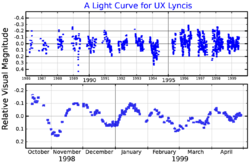Astronomy:UX Lyncis
 A visual band light curve for UX Lyncis. The top panel shows the variation over a period of years, and the lower plot shows the variation over a period of months. Adapted from Percy and Wilson (2001)[1] | |
| Observation data Equinox J2000.0]] (ICRS) | |
|---|---|
| Constellation | Lynx |
| Right ascension | 09h 03m 47.10789s[2] |
| Declination | +38° 44′ 31.6542″[2] |
| Apparent magnitude (V) | 6.6 - 6.78[3] |
| Characteristics | |
| Evolutionary stage | AGB[4] |
| Spectral type | M3III[5] or M6III[6] |
| B−V color index | 1.356±0.011[7] |
| Variable type | SRb:[4] |
| Astrometry | |
| Radial velocity (Rv) | +38.60±0.64[7] km/s |
| Proper motion (μ) | RA: −17.176[2] mas/yr Dec.: −20.823[2] mas/yr |
| Parallax (π) | 3.6035 ± 0.4422[2] mas |
| Distance | approx. 900 ly (approx. 280 pc) |
| Absolute bolometric magnitude (Mbol) | −0.15[7] |
| Details | |
| Radius | 128.38+0.92 −9.89[2] R☉ |
| Luminosity | 1,766±242[2] L☉ |
| Temperature | 3302+135 −11[2] K |
| Other designations | |
| Database references | |
| SIMBAD | data |
UX Lyncis is a variable star in the faint northern constellation of Lynx, positioned about 3° to the south of the 4th magnitude star 10 Ursae Majoris.[9] This is a red-hued star near the lower threshold of visibility to the naked eye, having an apparent visual magnitude that fluctuates around 6.70.[7] It is located at a distance of approximately 900 light years from the Sun based on parallax,[2] and is drifting further away with a radial velocity of +39 km/s.[7]
The stellar classification of this star is M3III,[5] while the infrared spectrum matches a class of M6III.[6] It is an aging red giant on the asymptotic giant branch that has exhausted the supply of both hydrogen and helium in its core, then cooled and expanded. At present it has 128[2] times the radius of the Sun, which is equivalent to 0.60 astronomical unit|AU or 60% of the distance from the Sun to the Earth. On average, it radiates a luminosity approximately 1,766 times that of the Sun from its swollen photosphere at an effective temperature of 3,302 K.[2] Infrared observations show little or no evidence for an oxygen-rich dusty shell around the star.[4]
The variability of this star was reported by R. L. Walker in 1970 from the U.S. Naval Observatory.[10] UX Lyncis has been classified as a semiregular variable ranging from magnitude 6.6 down to 6.78.[3] Its changes in brightness are complex, with a shorter period of 37.3 days due to the star's pulsations, and a longer period of 420 days possibly due to the star's rotation or convectively induced oscillatory thermal (COT) mode.[1] There is some evidence for an additional weak variability with a 29 day period.[11]
References
- ↑ 1.0 1.1 Percy, John R. et al. (2001). "Long-Term VRI Photometry of Small-Amplitude Red Variables. I. Light Curves and Periods". The Publications of the Astronomical Society of the Pacific 113 (786): 983–96. doi:10.1086/322153. Bibcode: 2001PASP..113..983P.
- ↑ 2.00 2.01 2.02 2.03 2.04 2.05 2.06 2.07 2.08 2.09 2.10 Brown, A. G. A. (August 2018). "Gaia Data Release 2: Summary of the contents and survey properties". Astronomy & Astrophysics 616: A1. doi:10.1051/0004-6361/201833051. Bibcode: 2018A&A...616A...1G. Gaia DR2 record for this source at VizieR.
- ↑ 3.0 3.1 Watson, Christopher (4 January 2010). "UX Lyncis". AAVSO Website. American Association of Variable Star Observers. http://www.aavso.org/vsx/index.php?view=detail.top&oid=17933.
- ↑ 4.0 4.1 4.2 Sloan, G. C.; Price, S. D. (December 1998). "The Infrared Spectral Classification of Oxygen-rich Dust Shells". The Astrophysical Journal Supplement Series 119 (2): 141–158. doi:10.1086/313156. Bibcode: 1998ApJS..119..141S.
- ↑ 5.0 5.1 Sato, K.; Kuji, S. (November 1990). "MK classification and photometry of stars used for time and latitude observations at Mizusawa and Washington.". Astronomy & Astrophysics Supplement Series 85: 1069. Bibcode: 1990A&AS...85.1069S.
- ↑ 6.0 6.1 Lebzelter, T.; Hron, J. (December 2003). "Technetium and the third dredge up in AGB stars. I. Field stars". Astronomy and Astrophysics 411 (3): 533–542. doi:10.1051/0004-6361:20031458. Bibcode: 2003A&A...411..533L.
- ↑ 7.0 7.1 7.2 7.3 7.4 Anderson, E.; Francis, Ch. (2012). "XHIP: An extended hipparcos compilation". Astronomy Letters 38 (5): 331. doi:10.1134/S1063773712050015. Bibcode: 2012AstL...38..331A.
- ↑ "UX Lyn". SIMBAD. Centre de données astronomiques de Strasbourg. http://simbad.u-strasbg.fr/simbad/sim-basic?Ident=UX+Lyn.
- ↑ Sinnott, Roger W.; Perryman, Michael A. C. (1997). Millennium Star Atlas. 2. Sky Publishing Corporation and the European Space Agency. p. 620. ISBN 0-933346-83-2.
- ↑ Walker, R. L. (July 1970). "Light Variations of BD+39°2193". Information Bulletin on Variable Stars 447: 1. Bibcode: 1970IBVS..447....1W.
- ↑ Percy, John R. et al. (April 2003). "Multiperiodicity in Five Small-Amplitude Pulsating Red Giants". The Publications of the Astronomical Society of the Pacific 115 (806): 479–483. doi:10.1086/374199. Bibcode: 2003PASP..115..479P.
 |

